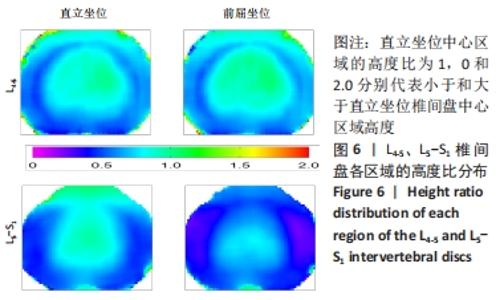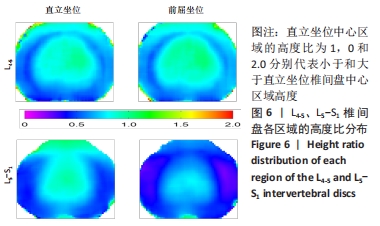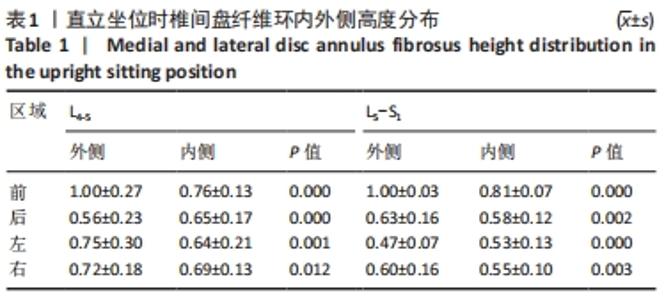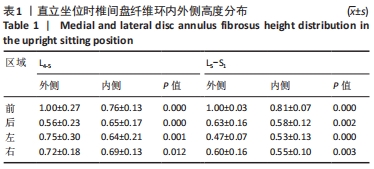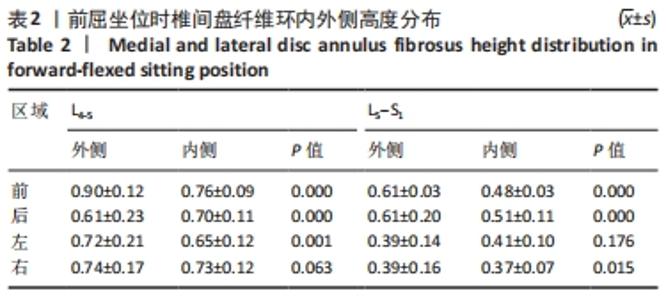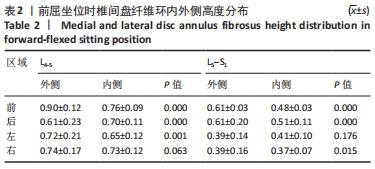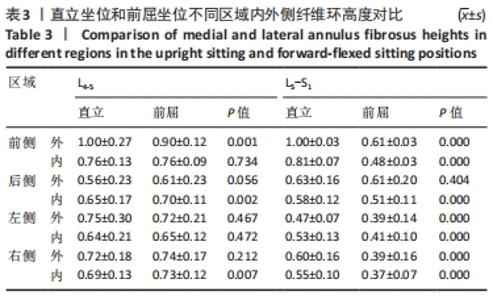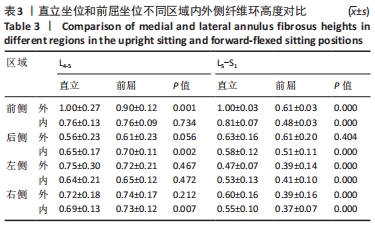Chinese Journal of Tissue Engineering Research ›› 2022, Vol. 26 ›› Issue (36): 5792-5797.doi: 10.12307/2022.797
Previous Articles Next Articles
Morphological changes and strain characteristics of lumbar intervertebral disc during sitting in forward flexion
Kou Bowen1, Han Ye1, Hao Yiguang1, Xu Haoxiang1, Wen Wangqiang1, Zhang Zepei2, Lan Jie2, Miao Jun2
- 1Tianjin Medical University, Tianjin 300000, China; 2Department of Spine Surgery, Tianjin Hospital, Tianjin University, Tianjin 300211, China
-
Received:2021-12-08Accepted:2022-01-13Online:2022-12-28Published:2022-04-27 -
Contact:Miao Jun, MD, Chief physician, Department of Spine Surgery, Tianjin Hospital, Tianjin University, Tianjin 300211, China -
About author:Kou Bowen, Master candidate, Tianjin Medical University, Tianjin 300000, China -
Supported by:the National Natural Science Foundation of China, No. 81472140 (to MJ)
CLC Number:
Cite this article
Kou Bowen, Han Ye, Hao Yiguang, Xu Haoxiang, Wen Wangqiang, Zhang Zepei, Lan Jie, Miao Jun. Morphological changes and strain characteristics of lumbar intervertebral disc during sitting in forward flexion[J]. Chinese Journal of Tissue Engineering Research, 2022, 26(36): 5792-5797.
share this article
Add to citation manager EndNote|Reference Manager|ProCite|BibTeX|RefWorks
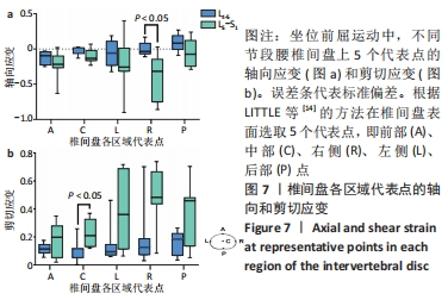
2.4 椎间盘各区域代表点的轴向应变 L4-5及L5-S1坐位前屈过程中各区域代表点的轴向应变见图7a,L4-5在前、中、左、右区域均呈现压缩应变,应变范围为-3.4%至-10%;在后方区域为拉升应变,拉升幅度为8.4%。L5-S1在前屈过程中均为压缩应变,应变范围为-8.3%至-32.2%。在右侧区域代表点R,L5-S1的压缩应变较L4-5显著增加28.3%(P=0.011)。 2.5 椎间盘各区域代表点的剪切应变 L4-5及L5-S1坐位前屈过程中各区域代表点的剪切应变见图7b,L4-5椎间盘剪切应变在各区域内分布较为均衡,应变范围为5.7%至-17.7%。L5-S1剪切应变较L4-5大,应变范围为19.3%-48.1%。在中心区域代表点C,L5-S1的剪切应变较L4-5显著增加14.8%(P=0.011)。"
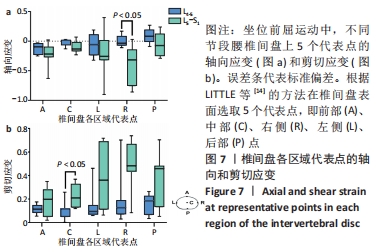
| [1] PHIMPHASAK C, SWANGNETR M, PUNTUMETAKUL R, et al. Effects of seated lumbar extension postures on spinal height and lumbar range of motion during prolonged sitting. Ergonomics. 2016;59(1):112-120. [2] BERGER-PASTERNAK B, BRYLKA D, SIPKO T. Lumbar Spine Kinematics in Asymptomatic People When Changing Body Position From Sitting to Standing. J Manipulative Physiol Ther. 2021;44(2):113-119. [3] PATWARDHAN AG, SIELATYCKI JA, HAVEY RM, et al. Loading of the lumbar spine during transition from standing to sitting: effect of fusion versus motion preservation at L4-L5 and L5-S1. Spine J. 2021;21(4):708-719. [4] SPYROPOULOS P, PAPATHANASIOU G. GEORGOUDIS G, et al. Prevalence of low back pain in greek public office workers. Pain Physician. 2007;10(5):651-659. [5] FRYER JC, QUON JA, SMITH FW. Magnetic resonance imaging and stadiometric assessment of the lumbar discs after sitting and chair-care decompression exercise: a pilot study. Spine J. 2010;10(4):297-305. [6] BLÁFOSS R, SKOVLUND SV, LÓPEZ-BUENO R, et al. Is hard physical work in the early working life associated with back pain later in life? A cross-sectional study among 5700 older workers. BMJ Open. 2020;10(12):e040158. [7] 胡永善.下腰痛的生物力学特点及康复[J].颈腰痛杂志,2004,25(2):73-75. [8] HOLLINGSWORTH NT, WAGNER DR. The stress and strain states of the posterior annulus under flexion. Spine (Phila Pa 1976). 2012;37(18):E1134-E1139. [9] GALBUSERA F, NIEMEYER F, TAO Y, et al. ISSLS Prize in Bioengineering Science 2021: in vivo sagittal motion of the lumbar spine in low back pain patients-a radiological big data study. Eur Spine J. 2021;30(5):1108-1116. [10] JACOBSEN S, SONNE-HOLM S, ROVSING H, et al. Degenerative lumbar spondylolisthesis: an epidemiological perspective: the Copenhagen Osteoarthritis Study. Spine (Phila Pa 1976). 2007;32(1):120-125. [11] EVANS W, JOBE W, SEIBERT C. A cross-sectional prevalence study of lumbar disc degeneration in a working population. Spine (Phila Pa 1976). 1989;14(1):60-64. [12] LIN CC, LU TW, WANG TM, et al. In vivo three-dimensional intervertebral kinematics of the subaxial cervical spine during seated axial rotation and lateral bending via a fluoroscopy-to-CT registration approach. J Biomech. 2014;47(13):3310-3317. [13] WANG S, XIA Q, PASSIAS P, et al. Measurement of geometric deformation of lumbar intervertebral discs under in-vivo weightbearing condition. J Biomech. 2009;42(6):705-711. [14] LITTLE JP, PEARCY MJ, PETTET GJ. Parametric equations to represent the profile of the human intervertebral disc in the transverse plane. Med Biol Eng Comput. 2007;45(10):939-945. [15] TAVANA S, MASOUROS SD, BAXAN N, et al. The Effect of Degeneration on Internal Strains and the Mechanism of Failure in Human Intervertebral Discs Analyzed Using Digital Volume Correlation (DVC) and Ultra-High Field MRI. Front Bioeng Biotechnol. 2021;8:610907. [16] LIU Q, WANG TY, YANG XP, et al. Strain distribution in the intervertebral disc under unconfined compression and tension load by the optimized digital image correlation technique. Proc Inst Mech Eng H. 2014;228(5):486-493. [17] HEUER F, SCHMIDT H, WILKE HJ. The relation between intervertebral disc bulging and annular fiber associated strains for simple and complex loading. J Biomech. 2008;41(5):1086-1094. [18] 潘承良,白芃,韩青,等.中国东北地区人群腰部节段椎间盘形态学参数CT三维测量及应用[J].中国实验诊断学,2019,23(11):1883-1887. [19] BYRNE RM, AIYANGAR AK, ZHANG X. A Dynamic Radiographic Imaging Study of Lumbar Intervertebral Disc Morphometry and Deformation In Vivo. Sci Rep. 2019;9(1):15490. [20] SONG Y, WEN WQ, XU J, et al. Kinematic Characteristics and Biomechanical Changes of Lower Lumbar Facet Joints Under Different Loads. Orthop Surg. 2021; 13(3):1047-1054. [21] SIEPE CJ, KORGE A, GROCHULLA F, et al. Analysis of post-operative pain patterns following total lumbar disc replacement: results from fluoroscopically guided spine infiltrations. Eur Spine J. 2008;17(1):44-56. [22] SIEPE CJ, MAYER HM, HEINZ-LEISENHEIMER M, et al. Total lumbar disc replacement: different results for different levels. Spine (Phila Pa 1976). 2007;32(7):782-790. [23] 王少锋,孟小庆,吴占勇,等.腰椎CT矢状面屈曲角、终板屈曲深度和双侧腰大肌横断面积差值诊断腰椎间盘突出症(LDH)的价值及与退变程度的关系[J].影像科学与光化学,2021,39(3):386-390. [24] 孙卓然,姜帅,邹达,等.国人青年人群坐-立位脊柱-骨盆矢状位序列变化研究[J].中国脊柱脊髓杂志,2018,28(4):325-329. [25] HARRISON DD, HARRISON SO, CROFT AC, et al. Sitting biomechanics part I: review of the literature. J Manipulative Physiol Ther. 1999;22(9):594-609. [26] HUANG M, HAJIZADEH K, GIBSON I, et al. Analysis of compressive load on intervertebral joint in standing and sitting postures. Technol Health Care. 2016; 24(2):215-223. [27] LEDET EH, TYMESON MP, DIRISIO DJ, et al. Direct real-time measurement of in vivo forces in the lumbar spine. Spine J. 2005;5(1):85-94. [28] ADAMS MA, HUTTON WC. The effect of posture on the role of the apophysial joints in resisting intervertebral compressive forces. J Bone Joint Surg Br. 1980; 62(3):358-362. [29] WANG Y, LI D, ZHU M, et al. Lumbar Facet Tropism on Different Facet Portions and Asymmetry Between Ipsilateral Cephalad and Caudad Portions: Their Correlations With L4/5 and L5/S1 Lumbar Disc Herniation. Spine (Phila Pa 1976). 2020;45(20):E1312-E1318. [30] ZHOU Z, NI HJ, ZHAO W, et al. Percutaneous Endoscopic Lumbar Discectomy via Transforaminal Approach Combined with Interlaminar Approach for L4/5 and L5/S1 Two-Level Disc Herniation. Orthop Surg. 2021;13(3):979-988. [31] GAWRI R, ROSENZWEIG DH, KROCK E, et al. High mechanical strain of primary intervertebral disc cells promotes secretion of inflammatory factors associated with disc degeneration and pain. Arthritis Res Ther. 2014;16(1):R21. [32] GRUEVSKI KM, CALLAGHAN JP. The effect of age, prolonged seated work and sex on posture and perceived effort during a lifting task. Appl Ergon. 2020;89:103198. |
| [1] | Zhan Yi, Wang Biao, Ma Yuli, He Simin, Sun Honghui, Hao Dingjun. Biomechanical comparison between a novel bone cement screw system and common surgical methods for the treatment of Kummell’s disease [J]. Chinese Journal of Tissue Engineering Research, 2023, 27(3): 385-390. |
| [2] | Wei Guoqiang, Li Yunfeng, Wang Yi, Niu Xiaofen, Che Lifang, Wang Haiyan, Li Zhijun, Shi Guopeng, Bai Ling, Mo Kai, Zhang Chenchen, Xu Yangyang, Li Xiaohe. Biomechanical analysis of non-uniform material femur under different loads [J]. Chinese Journal of Tissue Engineering Research, 2022, 26(9): 1318-1322. |
| [3] | Bi Jingwei, Ren Jiabin, Liu Xin, Sun Ning, Li Rui, Li Yuefei, Sun Zhaozhong. 3D-CT-guided unilateral biportal endoscopic localization of L5 and S1 nerve roots and intervertebral space [J]. Chinese Journal of Tissue Engineering Research, 2022, 26(33): 5283-5289. |
| [4] | Li Yanting, Chen Jian, Liu Menglan, Ren Manman, Zhong Weihong, Chen Changxing. Three-dimensional finite element analysis of Daogaijinbei manipulation on lumbar intervertebral disc biomechanics [J]. Chinese Journal of Tissue Engineering Research, 2022, 26(3): 340-343. |
| [5] | Cai Feng, Yu Bo, Zeng Duo, Chen Qincan, Liao Qi. Cortical bone trajectory in elderly patients with osteoporosis of lumbar disease [J]. Chinese Journal of Tissue Engineering Research, 2022, 26(3): 403-407. |
| [6] | Zhou Zhihao, Alafate·Kahaer, Wang Yixi, Liu Dongshan, Xieraili·Maimaiti, Shi Wenjie, Paerhati·Rexiti. Biomechanical properties of traditional trajectory screw technique and modified cortical bone trajectory technique: a finite element analysis [J]. Chinese Journal of Tissue Engineering Research, 2022, 26(18): 2789-2794. |
| [7] | Gong Haiyan, Cheng Qian, Zhao Zhilong, Shi Yang. Construction of pgaABCD gene deletion and complementation strains and properties of biofilm formation ability for Escherichia coli [J]. Chinese Journal of Tissue Engineering Research, 2022, 26(17): 2738-2743. |
| [8] | Yu Yang, Tang Liuyi, Hu Jiang, Wan Lun, Zhang Wei, Lin Shu, Wang Fei. Robot-assisted percutaneous vertebroplasty in the treatment of pathological fractures of thoracolumbar multivertebra [J]. Chinese Journal of Tissue Engineering Research, 2022, 26(16): 2467-2472. |
| [9] | Li Yuan, Song Liang, Zhang Jianguo, Hu Fengling. Three-dimensional finite element analysis of stress distributions in osteoporosis and normal mandibular dental implant-supported overdentures with flat-type and cushion-type magnetic attachments [J]. Chinese Journal of Tissue Engineering Research, 2022, 26(16): 2540-2544. |
| [10] | Xie Fei, Jia Peng, Liu Jiaxin, Liu Lu, Zhang Chunqiu, Ye Jinduo. Effect of loading mode on stress distribution in head and neck of the femoral stem [J]. Chinese Journal of Tissue Engineering Research, 2022, 26(15): 2302-2306. |
| [11] | Xu Feng, Kang Hui, Wei Tanjun, Xi Jintao. Biomechanical analysis of different fixation methods of pedicle screws for thoracolumbar fracture [J]. Chinese Journal of Tissue Engineering Research, 2021, 25(9): 1313-1317. |
| [12] | Yao Rubin, Wang Shiyong, Yang Kaishun. Minimally invasive transforaminal lumbar interbody fusion for treatment of single-segment lumbar spinal stenosis improves lumbar-pelvic balance [J]. Chinese Journal of Tissue Engineering Research, 2021, 25(9): 1387-1392. |
| [13] | Liu Zhichao, Zhang Fan, Sun Qi, Kang Xiaole, Yuan Qiaomei, Liu Genzhe, Chen Jiang. Morphology and activity of human nucleus pulposus cells under different hydrostatic pressures [J]. Chinese Journal of Tissue Engineering Research, 2021, 25(8): 1172-1176. |
| [14] | Guan Qian, Luan Zuo, Ye Dou, Yang Yinxiang, Wang Zhaoyan, Wang Qian, Yao Ruiqin. Morphological changes in human oligodendrocyte progenitor cells during passage [J]. Chinese Journal of Tissue Engineering Research, 2021, 25(7): 1045-1049. |
| [15] | Ren Hangning, Jurat·Matrozi, Paerhati·Rexiti, Luo Huiqing. Finite element analysis of lumbar vertebrae under the pull-out strength of screw in cortical bone trajectory technique [J]. Chinese Journal of Tissue Engineering Research, 2021, 25(36): 5771-5776. |
| Viewed | ||||||
|
Full text |
|
|||||
|
Abstract |
|
|||||


